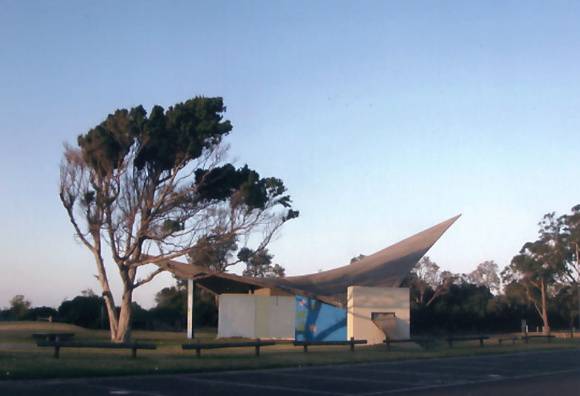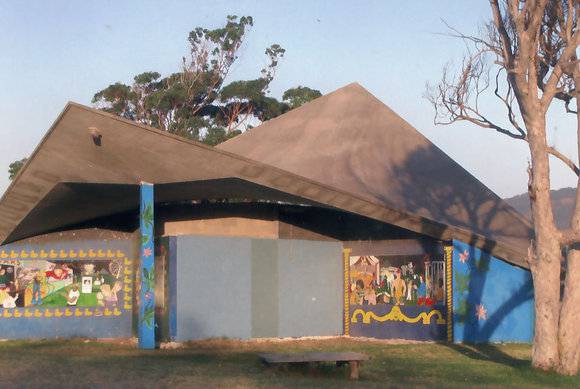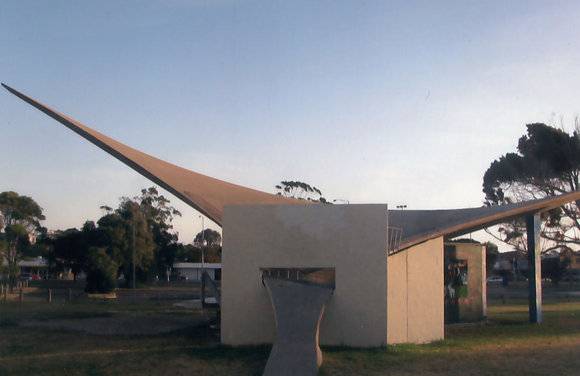| Back to search results » | Back to search page » |
|
Rosebud Sound Shell
LocationVillage Green, Foreshore Reserve Point Nepean Road (opposite 6th Avenue),,,,,,,,,,,,,,,, ROSEBUD VIC 3939 - Property No B0737
File NumberB0737LevelState |
|
Statement of Significance
What is significant? The Rosebud Sound Shellis a concrete structure comprising a series of enclosed rooms (containing toilet facilities and storerooms) and a raised stage or performance space, all sheltered by a hyperbolic paraboloid (hypar) concrete shell roof. Designed by local architect Ronald F Murcott, with specialist input from CSIRO engineers Dr John Brotchie and J L (Dick) van der Molen, the sound shell was erected by builder Trevor Luck in 1968-69 for the Rosebud Foreshore Committee. How is it significant? The Rosebud Sound Shell is of technological and aesthetic significance to the State of Victoria.
Why is it significant? Technologically, the Rosebud Sound Shell is significant as an example of a hyperbolic paraboloid structure. Essentially a curved surface generated by straight lines, the hypar was a much-publicised motif in international architecture from the early 1950s to the late 1960s. Its incorporation into the Rosebud Sound Shell is a rare survivor on several levels. While many architects around the world experimented with hypar geometry, few actual examples were ever realised in Australia. Only eight other local manifestations have been identified to date, of which four (including two others in Victoria) are confirmed as demolished. The Rosebud Sound Shell, moreover, is the only known surviving example in reinforced shell concrete (as opposed to timber or steel-framed construction); three other buildings with concrete hypar roofs (one in Perth and two in Sydney) have been destroyed.
Technologically, the sound shell is also significant for the participation of the CSIRO's Division of Building Research (and engineers Dr John Brotchie and J L van der Molen, both leading specialists in reinforced concrete design) and, more specifically, as one of the first concrete structures in Australia to be designed with the aid of a computer programme for structural analysis (which has become the norm). In this regard, the sound shell is comparable to (and barely pre-dated by) a concrete pedestrian bridge at Geelong, also designed by Dick van der Molen with CSIRO input.
Aesthetically, the sound shell is significant for its highly unusual expressionist form. By its very geometric nature, the hyperbolic paraboloid (a saddle shape, curving in two directions) is a striking motif unlike any other roof form. In this case, where the hypar is realised as a self-supporting concrete shell simultaneously viewable from both below and above (cf examples where the hypar roofs an enclosed building), it imparts an even more striking sculptural effect. This eye-catching expression, with intersecting curved planes, two corners that thrust upward to a point and two others that extend down into the ground, has very few direct comparators in post-war Australian architecture. It is by far the most distinctive example of this unusual building type in Victoria, and possibly in Australia. Sited as a free-standing object in a landscaped park setting, the sound shell remains a prominent foreshore landmark that can be experienced and appreciated from all sides.
Classified: 26/07/2010
Group
Recreation and Entertainment
Category
Other - Recreation & Entertainment






